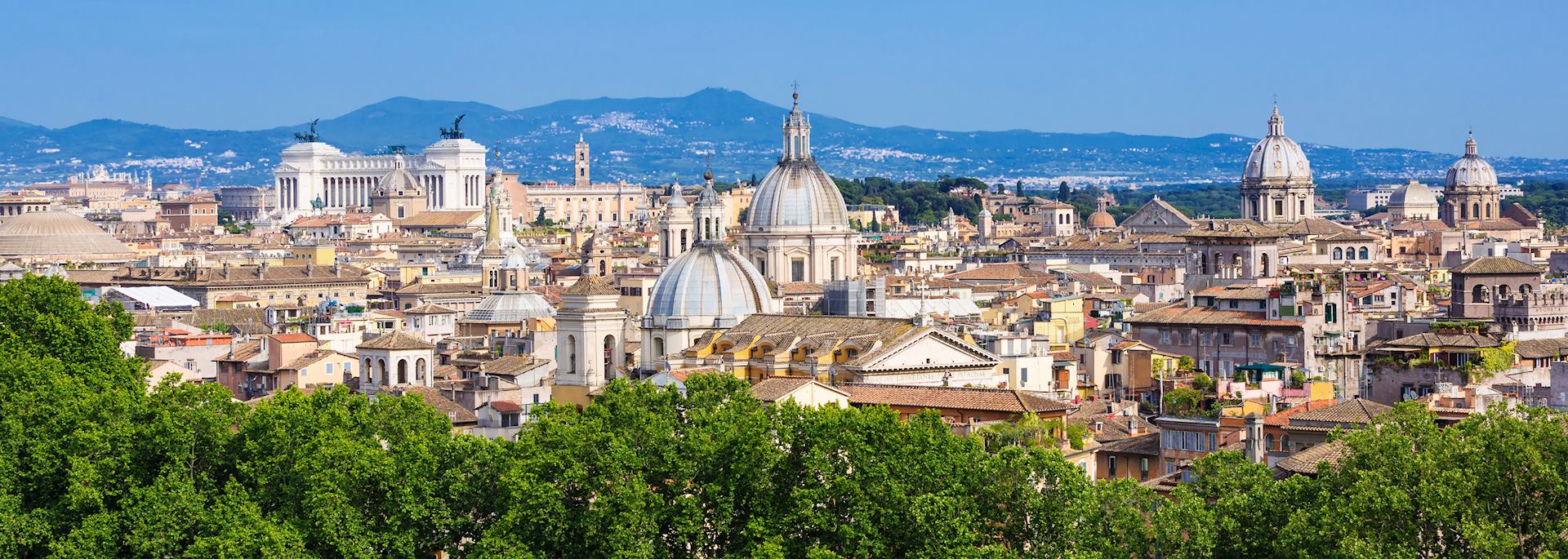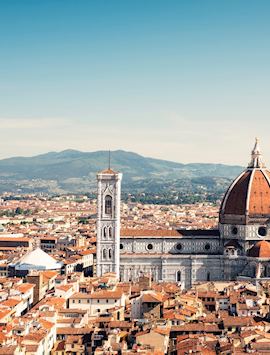By Italy specialist Caroline
Looking closely at some of the marble steps of the Forum, you might spot small divots carved into the stone, just a bit bigger than a €2 coin. These aren’t random pockmarks but relics of ancient dicing games. They’re tangible reminders of the era when citizens of Rome came to the Forum to gamble and debate the matters of the Republic.
These innocuous little hollows embody everything I love about Rome. Here you can stride along the streets where Julius Caesar walked, stand under the coffered dome that Hadrian built, and gaze at Michelangelo’s frescoes just as popes have done for 500 years.
Things to see & do in Rome
Day one — Ancient Rome


The Colosseum
Despite the depredations of time and man, the °ä´Ç±ô´Ç²õ²õ±ð³Ü³¾â€™s three ranks of arches and columns strike a jagged but soaring silhouette against the blue sky.
During its two millennia, the triple-tiered structure has served many purposes aside from an arena: a medieval fortress, a source for scavenged stone during the Renaissance, and now one of the most popular sights in Italy. As such, the lines for entrance can be staggering, so I strongly suggest buying skip-the-line ticket or, better, hiring a private guide.
As with many of the ancient sites, it can be hard to extrapolate meaning from skeletal remains of ruins, but a knowledgeable guide will flesh out the bare-bones stone structures. And there’s much to flesh out.
Innumerable gladiators, exotic animals and Christian martyrs all died on the sands here, their suffering cheered on by hordes of Romans. Canvas awnings could be deployed to shelter spectators from rain or sun. The watertight arena was sometimes flooded to set the stage for naval battles. Emperors would recreate important naval battles using small-scale ships.
The Roman Forum
The Forum was the heart of ancient Rome, a district filled with the administrative and spiritual buildings that conducted the business of the empire. That said, this extensive complex can seem perplexing at first. The scattered foundations, enigmatic freestanding walls and random columns rise up confusingly out of the grass. Even after visiting several times, I frankly found it a bit bewildering.
On a recent visit, though, my guide, Gabriella, managed to bring the whole complex to vivid life. Thanks to her rich descriptions, suddenly the whole place seemed animated — I could picture the soaring temples and toga-clad men striding down the bustling Via Sacra (the Forum’s main road). She also pointed out those remnants of long-ago dicing games.
At the end of the Via Sacra, you’ll find the Tempio di Giulio Cesare. It’s a bit hard to spot behind a low wall, but look for the bright collection of flowers left by visitors. The bouquets are intended to venerate Julius Caesar, who was cremated there. Close by, you can look for the tumble-down red-brick remains of the Rostri, the podium where Shakespeare had Mark Antony deliver his immortal ‘Friends, Romans, countrymen… ’ speech.

Palatine Hill
The aristocrats and emperors of Rome lived high on Palatine Hill, where legend holds that Romulus established the city after murdering his twin, Remus.
The site is now occupied by umbrella pine trees and a series of majestic ruins, all that remains of the various palaces built by various families and emperors through the centuries (the very word ‘palace’ is derived from ‘Palatium,’ the hill’s Latin name). Various rulers added to this complex over the centuries, but most of what remains was built during the rule of Emperor Domitian in the late 1st century AD.
In addition to the remnants of the palace, the hill offers views of the Forum and Colosseum that are fit for an emperor.
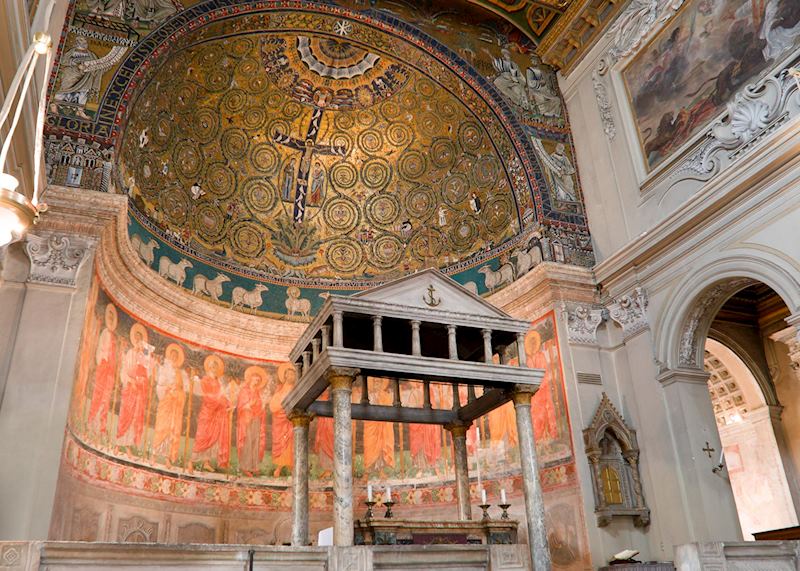
Basilica di San Clemente
For me, the best place to delve into Rome’s history is the Basilica di San Clemente. Not only is it much less crowded than the other sites, it offers a (literally) layered look into Rome’s past.
You enter the site by way of a 12th-century church, greeted by a Byzantine-style mosaic whose twining spirals and intricate adornment contrast sharply with the rest of the interior. Inside, much of the church was cobbled together from ancient sites. The marble columns predate the church by 1,000 years and the floor is laid with rare porphyry and serpentine tiles that would have been unobtainable after the fall of the empire.
From there, you descend one floor to a church built in the late 4th century, just after Rome declared Christianity legal. The brick walls sport repurposed frescoes, including one that depicts the Madonna wearing an unusual hat. In fact, it was originally a portrait of Byzantine Empress Theodora. You can also find some of the earliest examples — crass ones — of the written Italian language.
Descending further back in time, the lowest part of the edifice is a mishmash that includes not only a Roman apartment building but also a pagan temple. Here, a mystery cult worshipped the god Mithras and you can find an altar depicting the sacrifice of a bull as well as the edges of a ritual labyrinth, which is still largely unexcavated.
Though you’re as low as you can go, there’s one last layer. Under your feet, you can hear water rushing by in a sewer that dates to the era of the Roman Republic.
Day two — the Vatican Museums

It can be easy to get overwhelmed by the museums’ sheer scale as well as the crowds it attracts, so I always approach them with a plan and a guide. If at all possible, I arrive just as the museums open their doors for the day. And, I never visit on the once-a-month Sundays when admission is waived but the crowds multiply to unbearable levels.
The dress code is strictly enforced so be certain to wear clothing that covers your knees, shoulders and abdomen.
Sistine Chapel
As the crown jewel of the Vatican Museums, the Sistine Chapel can become exceptionally crowded. Being pressed together with other visitors in an overheated space can tarnish the experience of viewing Michelangelo’s peerless artwork.
Over the years, I’ve developed a tactic that helps me appreciate the chapel for what it was intended to be — a space of prayer and meditation. I arrive at the museums as soon as they open and speed through the galleries to the chapel, bypassing the millennia-worth of art and relics without a second glance.
I’m often one of just a few people in the chapel. It’s a totally different experience to stand, almost alone, in the hushed hall and gaze up at Michelangelo’s jewel-toned artwork, both on the ceiling and his colossal, lapis lazuli-dominated Giudizio Universale (Last Judgement) on the western wall. In the quiet, I can really appreciate the artist’s exceptional grasp of human anatomy and his exacting eye for movement.

Raphael Rooms
Having hurried to the Sistine Chapel, my second stop is always the Stanze di Raffaello, or Raphael Rooms. These four frescoed chambers were originally the private apartments of Pope Julius II and they feature some of Raphael’s most impressive work.
The School of Athens is often considered the masterpiece of the suite, but I prefer The Liberation of Saint Peter. The fresco portrays Saint Peter’s angelic rescue from Herod’s prison, and demonstrates Raphael’s exquisite skill at depicting light. The golden radiance of the angel’s divine nimbus contrasts with the cruel, geometrically rigid black bars of the prison gate.
Other galleries in the Vatican Museums
The two most popular attractions are always open — unless overcrowding prompts museum officials to close them off temporarily — but other rooms open on a rotating basis. There are so many galleries that you simply cannot explore them in just one visit, so a guide is crucial to get you to see what interests you.
There is much to choose from. One of the galleries is devoted to nothing but the vehicles that have been used to transport the pope. Another is frescoed with surprisingly accurate 16th-century topographical maps of Italy. You can also find large collections of art ranging from modern to Etruscan.
Day three — Rome’s other highlights

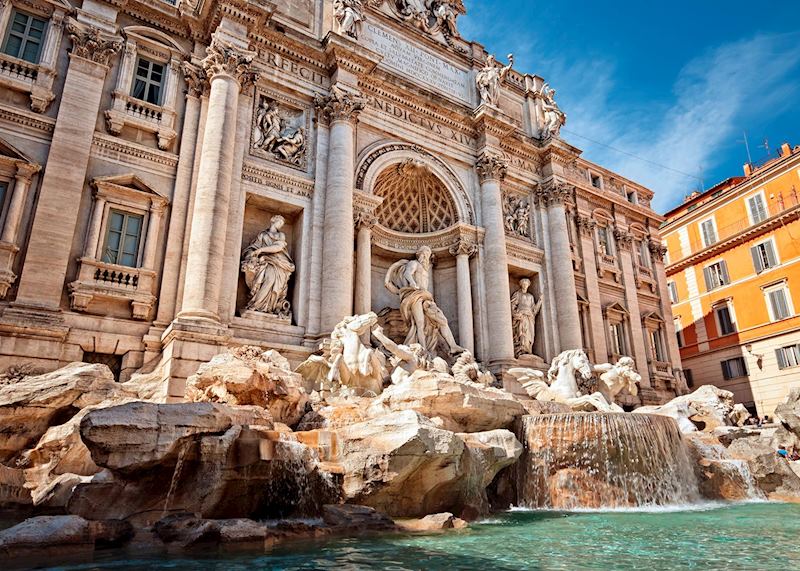
The Trevi Fountain
Arguably the queen of Rome’s many fountains, Trevi is a symphony of water fed by a still-functioning underground Roman aqueduct. In full-blown Baroque style, it cascades and froths its way through a succession of stone basins into the wide, shallow pool that Anita Ekberg gambolled through in the 1960 movie La Dolce Vita.
It’s almost compulsory to make a wish and toss a few coins into the pool. (The money, which totals several thousand euros every day, is donated to the city’s orphanages.)
The crowds can get thick, especially in the summer, so I suggest a stroll through the piazza in the early morning or just as the sun is setting. It’s also beautifully lit at night, when hardly anyone is there. Please, no matter how much you love La Dolce Vita, do not try to recreate Anita Ekberg’s frolic in the fountain’s waters. The polizia are not amused.
The Spanish Steps
Not far from the Trevi Fountain, the Spanish Steps have been drawing visitors since they were built in the 18th century. Known locally as the Scalinata della Trinità dei Monti, these broad, multi-tiered steps, and the piazza at their base, are an excellent place to sit and enjoy a bit of people watching.
At the top, you’ll find the Chiesa della Trinità dei Monti. This 16th-century church boasts frescoes by Daniele da Volterra, a pupil of Michelangelo. At the stairs’ foot is a fountain by Pietro Bernini, father of the better-known sculptor, fashioned in the shape of a boat as a nod to the piazza’s past vulnerability to flooding.
In the spring, the stairs are festooned with a riotous array of blooming azaleas as part of the celebration of the founding of Rome and it’s the site of a 19th-century nativity scene at Christmastime.

The Pantheon
Standing under the unblinking eye of the oculus and watching a beam of sunlight lance through the gloom under the vast coffered dome of the Pantheon is the most visceral experience of ancient Rome I can imagine. This is the empire’s best-preserved building, in Rome at any rate, and it remains a wonder of engineering even today, located just a short walk from the Trevi.
Historically, the Pantheon was thought to have been built as a temple to all gods, though some recent evidence has muddled that narrative. The building was consecrated as a Christian church in the early 7th century and is now officially called the Basilica di Santa Maria ad Martyres.
That status likely helped preserve the Pantheon from the worst of the medieval plundering that stripped the city’s other ancient buildings of their façades and ornamentation. Even so, the Pantheon didn’t escape entirely unscathed — Bernini used the bronze from the portico in his canopy over the papal altar for Saint Peter’s Basilica.
The main feature is the enormous unsupported concrete dome, the largest in the world. The mathematical precision of the engineering is apparent even to a layman. I wasn’t surprised to learn that the height from floor to oculus and the diameter of the dome are exactly equal, making it a perfect half sphere.
Day four — Hidden Rome
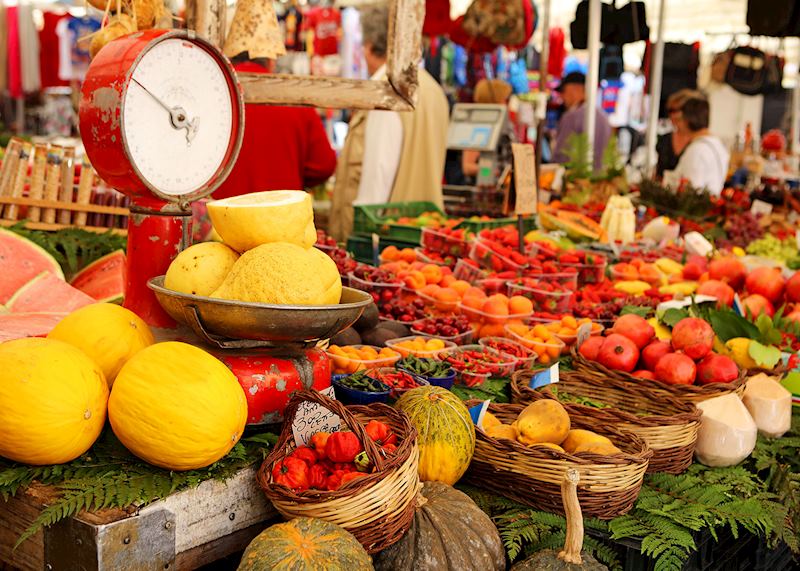
Food tour of the Jewish Ghetto
Romans sometimes call their city Caput Mundi, capital of the world. As the hub of a sprawling, cosmopolitan empire, Rome has historically incorporated a variety of cultures into its very fabric. An excellent example is the Jewish Ghetto, a walled quarter established in the 16th century.
Though once the site of crushing poverty and persecution, the ghetto is now one of the best places to explore Roman cuisine. On a recent walking tour, my guide, Gabriella, took me through the enclave’s quiet backstreets, popping in and out of small shops. I sampled traditional dishes from Roman, Jewish and Jewish-Roman cuisines, including fried artichokes, Roman pizza and mozzarella di bufala.
The tour also included a visit to the Campo de’ Fiori. The square hosts a bright and noisy food market by day and turns into a raucous outdoor party in the evening, when the many bars and cafés spill out into the cool night air.
Best time to visit Rome
Summer in Rome is both hot and crowded. I prefer to come in May and June or September and October.
Where to stay in Rome


A 17th-century palace-cum-hotel, Eitch Borromini is a perfectly located right in Piazza Navona. The rooms here are all suites, offering that rarest of Roman luxuries — space. Be sure to leave time for aperitifs on the rooftop terrace, which boasts one of the best views in the city.
Also conveniently located, the Villa Spalletti Trivelli is a grand former mansion on a quiet residential street near the Spanish Steps. The drawing room features a complimentary bar, elegant cardinal-red furniture, and an original piece of art by Rubens.
Start planning your trip to Italy
Start thinking about your experience. These itineraries are simply suggestions for how you could enjoy some of the same experiences as our specialists. They're just for inspiration, because your trip will be created around your particular tastes.
View All Tours in Italy